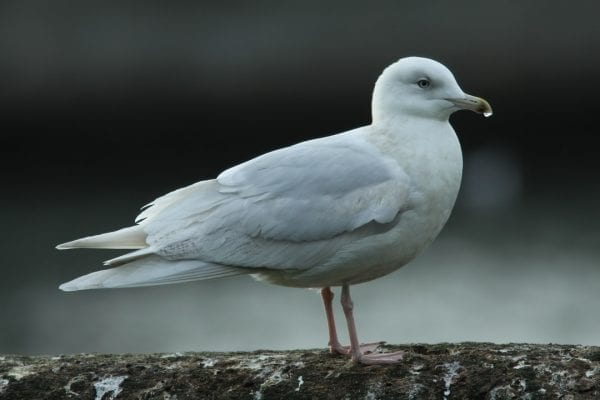
Iceland Gull
| Irish Name: | Faoileán Íoslannach |
| Scientific name: | Larus glaucoides |
| Bird Family: | Gulls |
green
Conservation status
Conservation status
Status
Scarce winter visitor to all Irish coasts from October to March.
Identification
About the same size as Herring Gull and very similar to that species. Differs in all ages in the colour of the wing-tips. Adult summer birds appear like Herring Gull with white head and underparts, while the back and wings are pale grey. Differs from Herring Gull in having white wing-tips however, as well as in having dark red (not pale) legs. Adult winter Iceland Gulls are similar to summer-plumaged birds, except for densely streaked head and neck. First winter Iceland Gulls are a very distinct coffee-brown colour all over with white or beige wing tips. The bill is comparatively short and dark with a pale pinkish base. In many birds, the brown tends to fade towards white in the course of the winter, so that by spring they may appear all white. Second-winter Iceland Gulls appear much like faded first-winters though have much reduced brownish markings on the wing and neck. Third-winter birds are virtually identical to adult winter Iceland Gulls. In comparison to Glaucous Gull (especially in adult plumage), Iceland Gull always appears smaller and "neater", lacking the "aggresive" appearance of the former. Other features to look for is whether the wing tips project beyond the tail on a resting bird and in first-winter birds, the amount pink and black on the bill (>50% pink = Glaucous Gull). These features are subjective however and require some experience.
Voice
Similar to that of the Herring Gull.
Diet
Omnivorous, scavenging around rubbish tips and harbours.
Breeding
Does not breed in Ireland. Despite its name, Iceland Gull does not breed in Iceland, with the main breeding range centred on Greenland and eastern Arctic Canada.
Wintering
Iceland Gulls winter along the coast of north-eastern North America and Western Europe. The numbers wintering in Ireland fluctuate from year to year with around 20 to 40 present most years.








